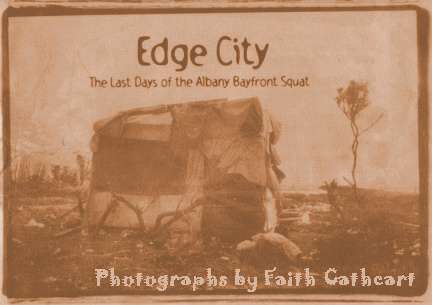EDGE CITY
--------------------
Online post date: May 28, 1999
- News Story: EDGE CITY
a reprint of the East Bay Express article of that name
by Chris Thompson, reporter, and
Faith Cathcart, social documentary
freelance photographer
April 9, 1999: page 1
| PAGE 1 | page 2 | page 3 | page 4 | page 5 |
 EDGE CITY
EDGE CITY
(page 1 OF 5)
By Chris Thompson
Alex McElree is a man who spends his days in a fog of sympathetic melancholy, a condition perhaps not unlike the icy drizzle that soaks our heads as he and I stand outside the gates of the Albany landfill. He's shot at men in the jungles of Vietnam and made a living picking up the lifeless bodies of Oakland homicide victims. He's walked homeless through the streets of the Bay Area and has felt his heart stop in his chest. Now, 52 years old and the executive director of Operation Dignity, an Oakland-based service provider for homeless veterans, he's dressed in a yellow slicker and Navy hat and leans against a surplus Navy ambulance. There's a story, he says, that goes a long way toward explaining why he still struggles with suicidal depression. He describes how, just south of Webster, at the entrance to the Estuary Tunnel, there's a freeway retaining wall. Behind that wall, a tribe of four homeless men live in the eerie fluorescent twilight near the tunnel, with its white noise and the exhaust of endless car engines. "They say they get used to it, but I don't know how," McElree says. "I go home some nights, and I just start crying, because I just don't understand how we can do this to our own people."
It's late on a Friday afternoon, a dark day gripped by a cold that drains the feeling from our fingers. McElree and his assistants have just hefted two wooden barriers from a gravel road in Albany that leads to a small stretch of "reclaimed" land jutting a mile into the bay, just north of Golden Gate Fields. This bulb-shaped promontory once served as a dumping ground for the remains of demolished buildings; for years trucks rumbled in and deposited tons of broken concrete and iron reinforcing bar. In 1984, the city of Albany closed the landfill, leaving it to the plants, birds, and jackrabbits that eventually colonized it.
Then, around 1993, a new species began to call this place home. A small group of squatters moved in and erected a tent city among the weeds and ten-year-old saplings. Pioneered by young punkers and urban deep ecology anarchists, a settlement slowly grew. For a time, dog-walking locals strode past this scattered collection of isolated shanties deliberately constructed to blend in with the environment-and never knew it. Everyone had an acre of peaceful open space to themselves, living a strangely rural existence surrounded by the stunning vistas of an urban metropolis. Open-air raves were held in a nearby pit called "the amphitheater," and enterprising artists welded the rebar into disjointed, compelling shapes.
Recently, however, two events have coincided to bring this once-serene culture to an end. First, the city of Albany extended construction of its part of the Bay Trail to the edge of the landfill, and more and more residents began hiking the area, rubbing elbows with the camp's dozens of inhabitants. In addition, a string of nearby homeless encampments were broken up last year, and the displaced residents began crowding onto the promontory. This was a marginal population of a different kind: older, often chronically homeless men and women with disturbing health problems and drug histories. The sudden density of inhabitants began to concentrate social problems in an area once benignly overlooked by the city. The scene's longtime residents complained that the landfill gradually became, well, sad, and began to leave.
| PAGE 1 | page 2 | page 3 | page 4 | page 5 |